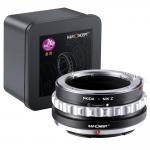
Pentax (PK/DA) Lens to Nikon Z Series Mount Camera High Precision Lens Adapter, PK/DA-NIK Z
SKU: KF06.491
it is an adapter that allows the use of out-of-production Nikon lenses (such as the D series) on Z series mirrorless cameras; therefore it has no electrical contacts, which are completely useless for lenses that are used with manual focus and do not transmit data to the camera and is not suitable for using lenses of the latest generations; it is well made, sturdy but at the same time light and fits well on both sides; it is contained in a practical plastic case (cardboard ones protect less and wear out easily); several buyers criticize the lack of protective caps, but since the adapter is completely empty inside there is actually nothing to protect, a cap would only be useful if the adapter were to be permanently inserted on a lens
14/11/2024
11/11/2024
The lens is well tightened on the adapter ring and the latter fits precisely and stably on the camera body. The Nikon Nikkor lens on Nikon Z camera. The adapter is well made with a matte interior to avoid reflections.
For the quality/price ratio I give 3 stars not because it is badly made obviously but because it costs more than other bayonet/camera body combinations. The overall deserves 5 stars as it works very well.
For the quality/price ratio I give 3 stars not because it is badly made obviously but because it costs more than other bayonet/camera body combinations. The overall deserves 5 stars as it works very well.
09/11/2024
I used it to pair old Nikkor manual lenses with the Nikon Zii. Obviously the camera only works manually with some difficulty focusing, because the mirrorless, unlike the digital one like the D810, does not have a colored dot to indicate when the focus is perfect.
08/11/2024
The FTZ adapter was easy to mount on my Z6ii, attaching the Nikon 24-120 FX was also no problem, the camera functions could be transferred to the lens.
The first impression is an inexpensive, very good solution
The first impression is an inexpensive, very good solution
08/11/2024
NIK-NIK Z ring Simple ring, no coupling: Nikon Z male bayonet, Nikon F female bayonet, which accepts pre-AI, AI, AIS lenses. We can therefore use old lenses whose pre-AI bayonet can damage the FTZ. No problem on a Nikon Z: the light is measured at the real aperture, and manual focusing is done with the color highlighting in the viewfinder. I use my old 50 mm 1.4, my 20mm 3.5 UD, my 300 4.5 Nikkor H, which are all three 50 years old... and my AI 50, 135 and 200. The ring is well built, no play and we have infinity. NIK (G)-NIK Z ring Please note, for Nikon G lenses, you need the Nikon FTZ, or the NIK (G)-NIK Z ring which allows you to operate their diaphragm, which does not have a ring on the lens. With the NIK-NIK Z, the G lens remains closed at its smallest aperture, without possible modification. Also be careful with the IBIS: you must record the focal length of the manual lens and indicate it to the camera when you use it: vibration compensation is much more effective if the Z camera knows the focal length.
03/11/2024
Low cost, sturdy.
What is it for and what is it not recommended for.
Excellent mount to be able to use in MANUAL mode (without Autofocus therefore and without CPU controls) Nikon F mount Manual lenses (both AI and AIS AF and AFD). It has no electrical contacts and electronics inside. Excellent for old lenses.
It does NOT have the features of the Nikon FTZ which instead supports AFS autofocus lenses and manages the CPU inside the lens.
It is recommended for all those who do not want to use their precious Nikon FTZ on old manual Nikon F lenses. To avoid damage to the FTZ, I chose in addition (and not as an alternative), this purely mechanical adapter.
So buy it too if you have these needs (aware that it does not support the autofocus of AFS and obviously previous lenses). Not as an alternative but in addition to the FTZ
What is it for and what is it not recommended for.
Excellent mount to be able to use in MANUAL mode (without Autofocus therefore and without CPU controls) Nikon F mount Manual lenses (both AI and AIS AF and AFD). It has no electrical contacts and electronics inside. Excellent for old lenses.
It does NOT have the features of the Nikon FTZ which instead supports AFS autofocus lenses and manages the CPU inside the lens.
It is recommended for all those who do not want to use their precious Nikon FTZ on old manual Nikon F lenses. To avoid damage to the FTZ, I chose in addition (and not as an alternative), this purely mechanical adapter.
So buy it too if you have these needs (aware that it does not support the autofocus of AFS and obviously previous lenses). Not as an alternative but in addition to the FTZ
02/11/2024
As usual with rings of this brand, it is perfectly machined. No play, clear and clean click.
Perfect.
Perfect.
01/11/2024
The ring allows you to mount the old Nikon F AI series manual lenses (even pre AI, to be honest) on the new Z series mirrorless camera bodies. You will have to adjust the exposure by acting directly on the lens aperture ring.
You can also mount autofocus lenses equipped with an aperture ring, in this case obviously losing all the automatic functions and focusing manually.
You can also mount autofocus lenses equipped with an aperture ring, in this case obviously losing all the automatic functions and focusing manually.
01/11/2024

